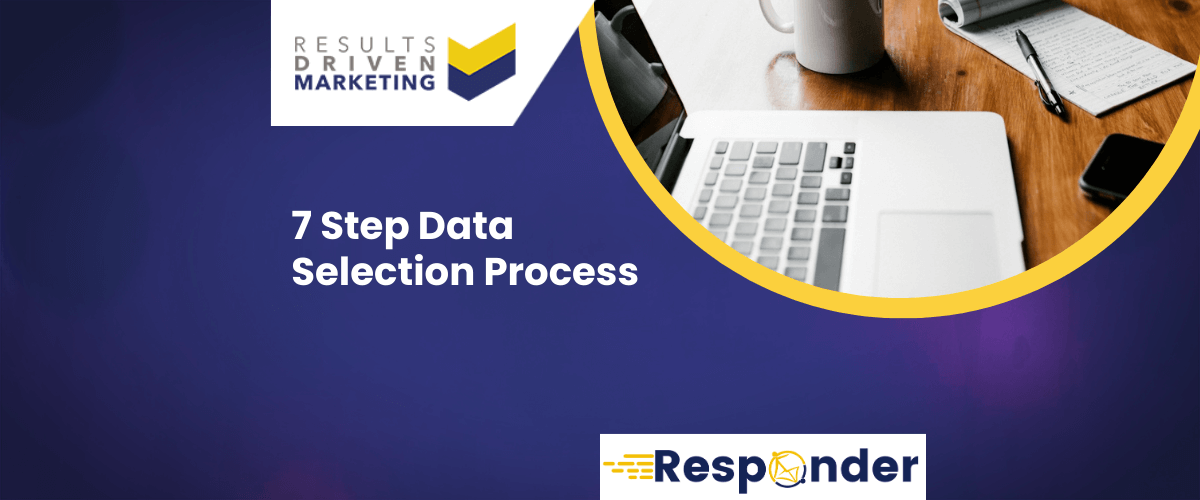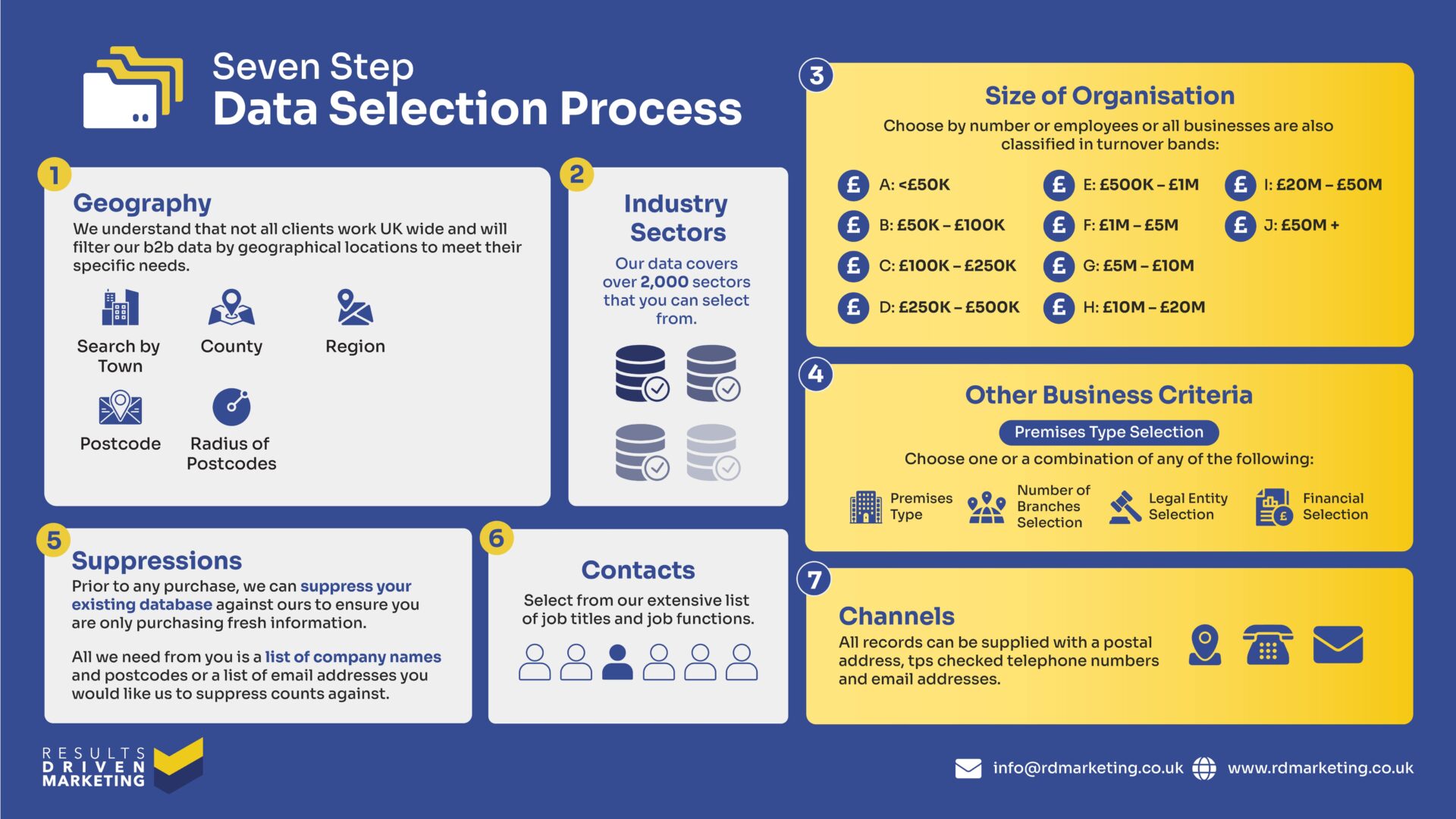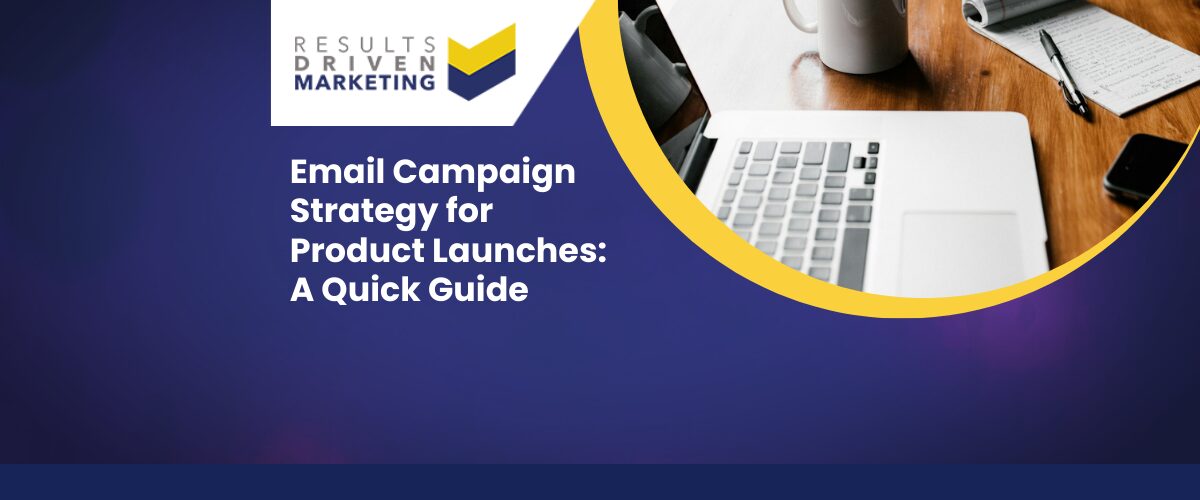
7 Step Data Selection Process
Data selection is at the core of every successful marketing campaign. Whether you’re running email marketing, telemarketing, or direct mail campaigns, selecting the right data ensures your message reaches the right people. But here’s the catch—many businesses struggle to get this step right. They either rely on outdated data, fail to segment effectively, or simply use low-quality sources. The result? Poor engagement, wasted budgets, and low return on investment (ROI).
This article walks you through a proven 7-step data selection process, designed to help you choose the most accurate, relevant, and GDPR-compliant data for your marketing efforts. By following these steps, you’ll significantly increase response rates, boost conversion rates, and get the most out of your marketing spend.
At RD Marketing, we specialise in providing high-quality B2B data that helps businesses target the right audience with precision. From B2B Data and Email Address Lists to Data Cleansing Services, we ensure your data is up-to-date, accurate, and legally compliant.
Now, let’s break down why data selection is so important, the common pitfalls to avoid, and how this 7-step process can transform your marketing results.
Table of contents:
Step 1: Define Your Campaign Goals
Before diving into data selection, the first and most important step is to define exactly what you want to achieve with your marketing campaign. Without clear goals, you’re essentially working with random data, which leads to poor targeting, low engagement, and wasted resources.
Setting specific objectives helps you:
Identify the right audience – Different goals require different data types and segmentation approaches.
Improve targeting – A well-defined goal ensures you’re reaching the right decision-makers.
Maximise campaign performance – When your data selection aligns with your objectives, engagement rates improve, and conversions increase.
Reduce waste – Poorly selected data means low response rates, high bounce rates, and budget inefficiencies.
Now, let’s look at some of the most common marketing goals and how they influence your data selection process.
What Are You Trying to Achieve?
Not all marketing campaigns are created equal. The data selection process you use should depend on your specific goal. Here are some key objectives businesses focus on:
Lead Generation
If your goal is to generate new leads, you need high-quality, verified contact data for businesses and decision-makers that match your ideal customer profile (ICP). The best approach is to use:
- B2B Data with accurate firmographic details such as industry, company size, and job title.
- Email Address List Data to run targeted email outreach campaigns.
- Telemarketing Data for direct phone-based prospecting and sales follow-ups.
Without proper segmentation, you risk reaching unqualified leads who have no interest in your product or service.
Brand Awareness
For businesses looking to increase visibility and engagement, the focus should be on broad but relevant targeting. This means selecting data that allows you to connect with:
- Industry professionals, potential partners, and influencers.
- Businesses operating in key markets where your brand needs recognition.
- A mix of decision-makers and influencers within an organisation.
Using International Email Lists is particularly useful if you’re expanding into new regions and want to raise awareness globally.
Event Promotion
If you’re organising a webinar, conference, or networking event, you need a targeted audience that will actually attend and engage. In this case, data selection should focus on:
Industry-specific contacts who have a direct interest in your event.
A High-quality email list that enable personalised invitations.
Validated phone numbers for SMS reminders and follow-up calls.
A strong combination of Direct Mail Data and Email Marketing Management Services helps you reach potential attendees effectively.
Customer Retention & Re-Engagement
Not all marketing efforts focus on new customer acquisition—sometimes the goal is to reconnect with past leads or existing customers. This requires clean, up-to-date data to ensure accurate targeting.
To avoid outdated contact details, businesses should:
- Regularly use Data Cleansing Services to remove inactive or incorrect information.
- Enrich existing databases with Data Enrichment Services, adding missing job titles, company details, and updated contact numbers.
By refining your existing data selection, you increase customer lifetime value and reduce churn.
How Clear Goals Improve Data Selection & Segmentation
Once you’ve identified your campaign objective, the next step is to align your data selection strategy to match. A goal-driven approach helps you:
Target the right prospects – No more wasted efforts on irrelevant contacts.
Personalise messaging – The more refined your audience, the better you can tailor content to their needs.
Optimise response rates – When your data selection is aligned with real customer intent, engagement improves.
Reduce campaign costs – Sending marketing material to the wrong audience is expensive and ineffective.
For example, if you’re reaching out to businesses in a regulated industry, using a CTPS Checker ensures your telemarketing campaigns are compliant with UK regulations.
By following this goal-driven data selection process, businesses can eliminate guesswork and create campaigns that deliver real results.
Final Thoughts on Step 1
Defining your campaign goals is the foundation of an effective data selection strategy. Whether you’re targeting new leads, building brand awareness, promoting an event, or re-engaging customers, aligning your data with specific marketing objectives is the key to higher engagement and better ROI.
In the next step, we’ll dive into how to identify your Ideal Customer Profile (ICP)—the next critical piece in the data selection process.
Geography
We understand that not all clients work UK wide and will filter our b2b data by geographical locations to meet their specific needs.
When it comes to running a successful marketing campaign, location matters.
As part of our proven seven-step data selection process, data selection geographically is a crucial step to ensure you’re targeting the right audience in the most relevant regions.
By focusing on geographic data, you can tailor your marketing efforts to specific areas, improving the effectiveness of your message and driving higher engagement.
Whether you’re looking to reach a local, national, or international audience, our data selection process ensures that your campaigns are precisely aligned with your target markets.
Search by County
County searches are popular with companies that work regionally.
They know where they operate and will simply ask for a b2b data count of companies in those counties.
It is incredibly easy for us to do and have included a list of counties below for you to select from.
Search by Postcode
Searching for b2b data by postcode is really useful for franchised businesses that have a set territory to work within or companies that are part of specific networks.
We have also supplied postcode specific b2b data to companies that have sales individuals working specific postcode areas.
In these instances, we can run counts based on several criteria and provide breakdowns for how many records are available each sales person.
Here is a full list of postcodes you can choose from.
Search by Radius of Postcode
Radius searches for b2b data are, in our opinion, under-used.
In most instances where companies operate regionally, but are not restricted by only working in certain postcodes or counties, radius searches work really well.
We can take your postcode and draw out a certain radius from there.
We can then supply a count on all the records we hold for businesses within that area.
Industry Sectors
Our data selection process covers over 2,000 sectors, giving you the flexibility to choose the exact industries you want to target.
We use both Lines of Business (LOBs) and Standard Industry Classifications (SICs) to ensure the data we provide is perfectly aligned with your specific sector requirements.
While many data suppliers rely solely on Standard Industry Classification (SIC) codes, these codes, chosen when a company registers with Companies House, may not always be suitable for marketing purposes.
They offer a broad classification that often doesn’t reflect the nuances of the companies within them. This can lead to less accurate targeting in your marketing campaigns.
To address this, our data selection process goes beyond SIC codes. We incorporate Lines of Business (LOBs), which break down these broad categories into more precise segments.
This means you can select exactly what you need, ensuring that your marketing efforts reach the most relevant audiences, without relying on guesswork.
Size of Organisation
When it comes to the data selection process, many clients need to target businesses of a specific size. One of the most effective ways to segment B2B data is by evaluating either the number of employees or a company’s turnover.
Our data selection process allows for both national and site-specific employee counts, providing flexibility in how you target businesses based on their size.
For instance, if you’re a training provider looking to work with companies that employ 100 people or more across multiple locations, solely focusing on employee counts at a single site could cause you to miss valuable prospects.
Alternatively, if you’re a supplier of renewable energy solutions, targeting large sites that consume significant amounts of energy is crucial. In this case, focusing only on national employee counts may surface businesses with 100 employees spread across multiple small sites, which may not fit your criteria.
Our data selection process also allows you to segment businesses by their turnover, offering a more detailed understanding of their scale.
All businesses in our database are classified into turnover bands, ranging from under £50K to £50M+, ensuring you have the insights you need to target the right businesses:
- A: <£50K
- B: £50K – £100K
- C: £100K – £250K
- D: £250K – £500K
- E: £500K – £1M
- F: £1M – £5M
- G: £5M – £10M
- H: £10M – £20M
- I: £20M – £50M
- J: £50M +
With these options, our data selection process ensures you can accurately target companies based on their size and revenue, enhancing the precision of your marketing campaigns.
Other Business Criteria
In our comprehensive data selection processes, targeting businesses based on specific criteria beyond industry and size can further refine your marketing strategy.
Our process allows you for data selection based on premises type, legal entity, number of branches, and financial health, giving you unmatched precision in reaching your ideal audience.
Premises Type Data Selection
You can tailor your targeting by choosing one or a combination of the following premises types:
- Single Site
- Head Office
- Business at Home
- Factories and Manufacturing
- Hospitals and Medical
- Office and Administration
- Places of Worship
- Police, Fire, Ambulance, Courts
- Sports, Leisure, Entertainment
- Transport
- Warehouses and Wholesale
- Workshops and Repair Centres
Legal Entity Data Selection
Our data selection processes also allow you to target companies based on their legal structure, including:
- Limited Liability Partnerships
- Private Limited Companies
- Public Limited Companies
Number of Branches Selection
For businesses looking to engage with multi-site organisations, our data selection processes enable you to specify the number of branches your target companies should have, helping you reach businesses that fit your operational needs.
Financial Selection
You can also refine your data selection based on the financial health of companies, selecting businesses based on:
- Profit or loss
- Profit change
- Net worth
- Sales increase or decrease
By incorporating these additional criteria into our data selection processes, you can achieve even greater precision in your marketing campaigns, ensuring you’re reaching the businesses that meet your specific requirements.
Suppressions
Concerned about duplicating data you already have? Our data selection process includes a suppression feature to ensure that you only receive fresh, valuable information.
Before making a purchase, we can suppress your existing database against ours, so you won’t end up buying data you already hold.
All we require is a list of company names and postcodes or email addresses that you would like us to suppress. By incorporating suppressions into our data selection process, we guarantee that the data you purchase is unique, helping you avoid redundancy and maximise the effectiveness of your campaigns.
Contacts
As part of our comprehensive data selection process, you can choose from an extensive list of job titles and job functions to ensure you’re reaching the right decision-makers within your target businesses.
Whether you’re looking to engage with executives, managers, or specific department heads, our data selection process provides the flexibility to target the exact contacts who can drive your marketing success.
Channels
Our data selection process ensures that all records come with the necessary contact details to support your multi-channel marketing efforts.
Whether you need postal addresses, TPS-checked telephone numbers, or email addresses, we provide everything required for effective direct marketing.
This allows you to seamlessly execute campaigns via post, phone, or email, maximising your outreach across all channels.
Who are we?
Thinking about “how do I buy data“?
Providing b2b database solutions is our passion.
Offering a consultancy service prior to purchase, our advisors always aim to supply a database that meets your specific marketing needs, exactly.
We also supply email marketing solutions with our email marketing platform and email automation software.
Results Driven Marketing have the best data of email lists for your networking solutions as well as direct mailing lists & telemarketing data in telemarketing lists
We provide data cleansing and data enrichment services to make sure you get the best data quality.
We provide email marketing lists and an international email list for your business needs.
At RDM We provide b2c data as we have connections with the best b2c data brokers.
A good quality b2b database is the heartbeat of any direct marketing campaign…
It makes sense to ensure you have access to the best!
Call us today on 0191 406 6399 to discuss your specific needs.
Results Driven Marketing
0191 406 6399








